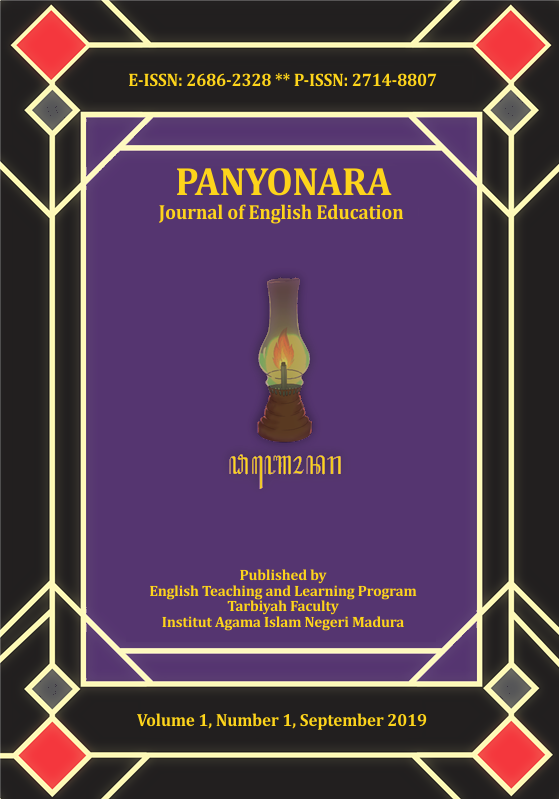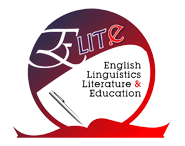The Comparison between Right Hemisphere Dominance Students and Left One in Multiple Choice of English Test at the First Grade MAN 2 of Pamekasan
 Abstract views: 304
,
Abstract views: 304
,
 PDF downloads: 352
PDF downloads: 352
Abstract
The brain is divided into two nearly symmetrical halves, the right, and the left hemisphere. Left hemisphere handles all of analytical, logical matters, and language skill. On the contrary, art objects such as music, imagination, and colors handled by the right one. This research investigated whether there is a significant difference between right hemisphere dominance students and left one in multiple choice of English test. The researcher used ex-post facto research. The population is 294 of first-grade students. The simple random sampling technique used to select 40 students (20 right hemisphere dominance students and 20 left one). In gaining the data, three instruments have been used namely questionnaire, test, and documentation. The data were analyzed using independent t-test. The result revealed that there is a significant difference between right hemisphere dominance students and left one at the first grade MAN 2 of Pamekasan in multiple choice of English test (2.16 > 2.03; Significance level 5%, df = 35). Left brain dominance students are better in multiple choice of English test because language skill is placed on the left hemisphere. It also notified that differ hemisphere dominance students give different effect to the students’ achievement in English testing, especially multiple-choice test.
Downloads
References
Ary, D., Jacobs, L. C., Razavieh, A., & Ary, D. (2010). Introduction to research in education (8th ed). Belmont, CA: Wadsworth.
Brown, H. D. (2000). Principles of Language Learning and Teaching (4th ed.). San Fransisco: Longman.
Brown, H. D. (2007). Principles of Language Learning and Teaching (5th ed.). San Fransisco: Longman.
Busan, T. (2005). Brain Child (Translated by Marselita Harapan). Jakarta: Gramedia.
Capacchione, L. (2001). The Power of Your Other Hand. USA: New Page Books.
Chaer, A. (2009). Psikolinguistik: Kajian Teoretik. Jakarta: Rineka Cipta.
Chomsky, N. (1994). Language File. Ohio: Ohio University State.
Décosterd, M. L. (2010). Right Brain/Left Brain President. Colorado: Praeger.
Djiwandono, S. (2008). Tes Bahasa. Jakarta: PT. Indeks.
Ellis, R. (1994). The Study of Second Language Acquisition. New York: Oxford University Press.
Emmorey, K. (2002). Language, Cognition, and the Brain. London: Lawrence Erlbaum Associates Publisher.
Fulcher, G. (2010). Practical Language Testing. London: Hodder Education.
Fulcher, G., & Davidson, F. (2007). Language Testing and Test. London: Routledge.
Hakuta, K., & Beatty, A. (2000). Testing English Language Learners in U.S. Schools. Washington, D.C.: National Academy Press.
Haladyna, T. M. (2004). Developing and Validating Multiple Choice Test Items (3rd ed.). London: Lawrence Erlbaum Associates Publishers.
Harmer, J. (2001). The Practice of English Language Teaching. London: Cambridge University Press.
Harris, D. P. (1969). Testing English as a Second Language. Bombay: Tata McGraww-Hill Publishing Company Ltd.
Harrish, J. (2002). What Every Parent Needs to Know About Standardized Test; How to Understand the Test and Help Your Kids Score High. New York: McGraw-Hill.
Kalat, J. W. (2011). Biopsikologi (Translated by Dhamar Pramudito). Jakarta: Salemba Humanika.
Muhammad, A. bin. (2008). Ibnu Katsir (Translated by Abu Ihsan). Jakarta: Pustaka Imam Syafi’i.
Osterlind, S. J. (1998). Constructing Test Items. New York: Kluwer Academic Publishers.
Pritchard, A. (2009). Ways of Learning. London: Routledge.
Saifuddin, I. A. (2010). Easy TOEFL. Yogyakarta: Buku Biru.
Semiawan, C. R. (2010). Kreativitas Keberbakatan. Jakarta: Indeks.
Siahaan, S. (2008). Issues in Linguistics. Yogyakarta: Graha Ilmu.
Solso, R. L. (2007). Psikologi Kognitif (Translated by Mikael Rahardanto). Jakarta: Erlangga.
Tea, T. (2009). Inpiring Teaching. Jakarta: Gema Insani Press.
The Qur’an Arabic Text with Corresponding Meanings. (1997). Riyadh: Abul Qosim Publishing House.
The journal uses an Open Access policy under a Creative Commons Attribution-NonCommercial 4.0 International License. Authors who publish with this journal agree to the following terms:
- Authors retain copyright and grant the journal right of first publication with the work simultaneously licensed under a Creative Commons Attribution License that allows others to share the work with an acknowledgment of the work's authorship and initial publication in this journal.
- Authors are able to enter into separate, additional contractual arrangements for the non-exclusive distribution of the journal's published version of the work (e.g., post it to an institutional repository or publish it in a book), with an acknowledgment of its initial publication in this journal.
- Authors are permitted and encouraged to post their work online (e.g., in institutional repositories or on their website) prior to and during the submission process, as it can lead to productive exchanges, as well as earlier and greater citation of published work.
















